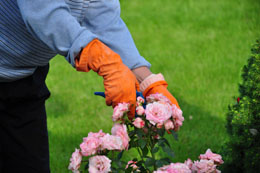A rose bush can be trimmed during fall or spring, just before the growing season. While trimming the bush, it is important to take some special care, so as to maintain the look of the plant and promote its healthy growth. Find out some simple tips on trimming rose bushes, in this Buzzle article.

Rose bushes can be a beautiful addition to any garden. In fact, many gardeners think that a flower garden is incomplete without roses. However, you cannot make your garden perfect by simply planting a rose bush, as this plant needs a lot of care and attention to produce those beautiful blossoms, which are cherished by every gardener. One of the most important part of plant care and maintenance is trimming or pruning, which is discussed in this article.
Importance of Trimming
The first obvious benefit of trimming is that it keeps a plant in proper size and shape, by checking the uncontrolled growth of branches. Secondly, it helps get rid of dead and decayed branches and leaves, that may ruin the beauty of the plant.
So, trimming helps maintain or enhance the look of a plant or tree. However, more importantly, pruning or trimming promotes new growth and better blooms, and improves air circulation by removing the weak and unwanted branches. It also ensures that all parts of the plant receive adequate sunlight for better growth.
The Right Time for Trimming
After knowing the benefits of trimming, the next obvious question is when to trim your rose bushes. The timing for trimming can vary depending on the species of rose, and the geographical location. In general, spring is the growing season for roses, and they become dormant during winter. So, many gardeners prefer the early springtime, just when the leaf buds swell, to remove all the dead branches and leaves, and trim back the stem. But this can be done during autumn as well, when the plant becomes dormant.
The Right Way to Trim
For trimming any plant, you should use sharp, clean, and properly sterilized tools. This would ensure that diseases like black spots do not spread from one plant to another. While pruning your rose bushes, first remove all dead, weak, decayed or diseased branches/wood. Also remove the branches that are crossed. The dead or diseased branches are usually black or brown, while leaves with black or yellow spots indicate the fungal disease, known as black spots.
Ideally, pruning should start from the base of the plant. While cutting the stem, maintain a 45 degree angle, which is very important. It means that the stem should be cut back to within ¼ inch, above a bud that is facing towards the plant. This in turn will ensure that the branches grow outwards instead of turning inwards.
In addition to dead branches, be sure to remove the dead blooms and canes. Once you have removed all dead and diseased parts of the plant, look for suckers that emerge from the bud union. Instead of cutting them, pull them out completely. As the winter approaches with a fall in temperature, remove the worn-out flowers and leaves from the bushes. But during summer, remove only the spent flowers. Occasional light pruning is sufficient during summer, in order to maintain the shape of the bushes. However, roses that bloom only once can be trimmed properly, when the blooming is over.
Proper trimming can ensure the healthy growth of plants, and you would see large and beautiful blooms in the growing season. The task may seems a bit difficult for the beginners. But with practice and attention to details, one can achieve the skills required for pruning rose bushes.






 Rose bushes can be a beautiful addition to any garden. In fact, many gardeners think that a flower garden is incomplete without roses. However, you cannot make your garden perfect by simply planting a rose bush, as this plant needs a lot of care and attention to produce those beautiful blossoms, which are cherished by every gardener. One of the most important part of plant care and maintenance is trimming or pruning, which is discussed in this article.
Rose bushes can be a beautiful addition to any garden. In fact, many gardeners think that a flower garden is incomplete without roses. However, you cannot make your garden perfect by simply planting a rose bush, as this plant needs a lot of care and attention to produce those beautiful blossoms, which are cherished by every gardener. One of the most important part of plant care and maintenance is trimming or pruning, which is discussed in this article.